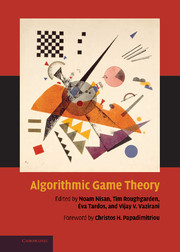Book contents
- Frontmatter
- Contents
- Foreword
- Preface
- Contributors
- I Computing in Games
- 1 Basic Solution Concepts and Computational Issues
- 2 The Complexity of Finding Nash Equilibria
- 3 Equilibrium Computation for Two-Player Games in Strategic and Extensive Form
- 4 Learning, Regret Minimization, and Equilibria
- 5 Combinatorial Algorithms for Market Equilibria
- 6 Computation of Market Equilibria by Convex Programming
- 7 Graphical Games
- 8 Cryptography and Game Theory
- II Algorithmic Mechanism Design
- III Quantifying the Inefficiency of Equilibria
- IV Additional Topics
- Index
6 - Computation of Market Equilibria by Convex Programming
from I - Computing in Games
Published online by Cambridge University Press: 31 January 2011
- Frontmatter
- Contents
- Foreword
- Preface
- Contributors
- I Computing in Games
- 1 Basic Solution Concepts and Computational Issues
- 2 The Complexity of Finding Nash Equilibria
- 3 Equilibrium Computation for Two-Player Games in Strategic and Extensive Form
- 4 Learning, Regret Minimization, and Equilibria
- 5 Combinatorial Algorithms for Market Equilibria
- 6 Computation of Market Equilibria by Convex Programming
- 7 Graphical Games
- 8 Cryptography and Game Theory
- II Algorithmic Mechanism Design
- III Quantifying the Inefficiency of Equilibria
- IV Additional Topics
- Index
Summary
Abstract
We introduce convex programming techniques to compute market equilibria in general equilibrium models. We show that this approach provides an effective arsenal of tools for several restricted, yet important, classes of markets. We also point out its intrinsic limitations.
Introduction
The market equilibrium problem consists of finding a set of prices and allocations of goods to economic agents such that each agent maximizes her utility, subject to her budget constraints, and the market clears. Since the nineteenth century, economists have introduced models that capture the notion of market equilibrium. In 1874, Walras published the “Elements of Pure Economics,” in which he describes a model for the state of an economic system in terms of demand and supply, and expresses the supply equal demand equilibrium conditions (Walras, 1954). In 1936, Wald gave the first proof of the existence of an equilibrium for the Walrasian system, albeit under severe restrictions (Wald, 1951). In 1954, Nobel laureates Arrow and Debreu proved the existence of an equilibrium under much milder assumptions (Arrow and Debreu, 1954).
The market equilibrium problem can be stated as a fixed point problem, and indeed the proofs of existence of a market equilibrium are based on either Brouwer's or Kakutani's fixed point theorem, depending on the setting (see, e. g., the beautiful monograph (Border, 1985) for a friendly exposition of the main results in this vein).
- Type
- Chapter
- Information
- Algorithmic Game Theory , pp. 135 - 158Publisher: Cambridge University PressPrint publication year: 2007
- 13
- Cited by

